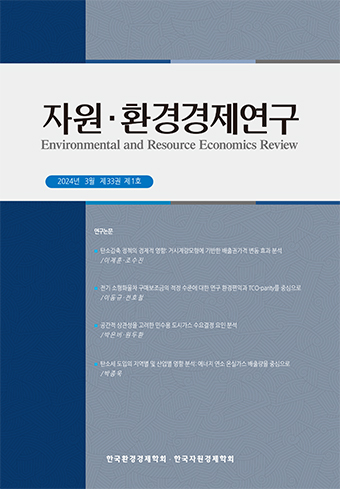Research Paper
Abstract
References
Information
Carbon neutral policy in Korea pays limited attention to the concept of sustainable economic growth. This limitation can be compared with other countries' carbon neutral policies such as US, UK and China where the climate change policies are closely connected to economic policies to boost further economic growth. This paper adopts a Ramsey growth model to account for the impact of carbon neutral policy on long-term economic growth and the accumulation capital. The model incorporates the Hartwick rule to allow sustainability of economic growth by transforming resource input into other input factor for growth. The analysis provides a possibility of low accumulation of capital as a result of carbon neutral policy in the absence of effective transformation of fossil-fuel factor into growth-related productive capital. Such low capital stock can be more aggravated when there exists a rent-seeking behavior of various interest groups with voracity to exploit social capital.
국내의 탄소중립 정책은 다분히 온실가스 감축정책 위주로 구성되어 있는 것에 반해 미국, 영국, 중국 등 탄소중립을 선언한 국가는 경제성장과 기후변화를 동시에 달성하겠다는 목표를 갖고 있다. 본 논문은 온실가스 배출의 넷제로를 의미하는 탄소중립 개념을 램지의 경제성장 모형에 포함함으로써 탄소중립 정책이 자본축적의 장기적 동태적 과정에 미치는 효과를 분석하였다. 아울러 지속가능한 경제성장을 달성하기 위한 이른바 하트윅 규칙을 내포하였다. 넷제로의 탄소중립이 자본과 소비 경로의 정상상태와 더불어 나타날 때의 정상상태 균형을 분석하였다. 분석 결과를 보면, 램지 모형에 탄소중립과 하트윅 규칙을 포함할 경우 자본의 축적이 저규모 수준에서 정상상태에 도달하는 것으로 나타났다. 또한 재생에너지 확대가 다수의 이해집단에 의해 지대추구 대상이 될 때에는 자본축적 규모가 보다 더 악화될 수 있기 때문에, 에너지 전환과정에 공정한 시장제도 설계가 중요함을 알 수 있다.
- Asheim, G. B., W. Bucholz, J. M. Hartwick, T. Mitra, and C. Withagen, “Constant savings rates and quasi-arithmetic population growth under exhaustible resource constraints,” Journal of Environmental Economics and Management, Vol. 53, 2007, pp. 213~229.10.1016/j.jeem.2006.09.001
- Cairns, R. D., and N. V. Long, “Maximin: a direct approach to sustainability,” Environment and Development Economics, Vol. 11, 2006, pp. 275~300.10.1017/S1355770X06002877
- Daly, H. E., Steady-State Economics. EarthScan Publication Ltd. 1992, 16p.
- Dasgupta, P., and G. M. Heal, “The optimal depletion of exhaustible resources,” Review of Economic Studies, Vol. 41, 1974, pp. 3~28.10.2307/2296369
- Dixit, A., P. Hammond, and M. Hoel, “On Hartwick’s rule for regular maximin paths of capital accumulation and resource depletion,” Review of Economic Studies, Vo. 47, 1980, pp. 55~556.10.2307/2297306
- Gennaioli, C., and M. Tavoni, Clearn or ‘dirty’ energy: evidence on a renewable energy resource curse, London School of Economics, 2012.10.2139/ssrn.1920145
- Georgescu-Roegen, N., “The steady state and ecological salvation: a thermo-dynamic analysis,” Bioscience, Vol. 27, No. 4, 1977, pp. 266~270.10.2307/1297702
- Georgescu-Roegen, N., Entropy and Bioeconomics, Nagard, 1993, pp. 184~201.
- Hartwick, J., “Intergenerational equity and the investing of rents from exhaustible resources,” American Economic Review, Vol. 66. 1977, pp. 972~974.
- Jabbari, M., M. S. Motlagh, K. Ashrafi, and G. Abdoli, “Global carbon budget allocation based on Rawlsian Justice by means of the Sustainable Development Goals Index,” Environment, Development and Sustainability, Vol. 22, 2020, pp. 5465~5481.10.1007/s10668-019-00433-1
- Kerschner, C. “Economic de-growth vs. steady-state economy,” Journal of Cleaner Production, Vol. 18. 2010, pp. 544~551.10.1016/j.jclepro.2009.10.019
- Kryger, K. S., A Resource curse for renewables? a case study of the Indonesian solar energy sector, Aalborg University, Denmark. 2017.
- Kwon, T-H., “Rent and rent-seeking in renewable energy support policies: Feed-in tariff vs. renewable portfolio standard,” Renewable and Sustainable Energy Reviews, Elsevier. Vol. 44, 2015, pp. 676~681.10.1016/j.rser.2015.01.036
- Lane, P. R., and A. Tornell, “Power, growth and the voracity effect,” Journal of Economic Growth, Vol. 1, 1996, pp. 213~241.10.1007/BF00138863
- Rawls, J., A Theory of Justice, Clarendon Press, Oxford. 1972.
- Schumpeter, J. A., The Theory of Economic Development: An Inquiry into Profits, Capital, Credit, Interest and the Business Cycle, Oxford University Press. 1961.
- Stiglitz, J., “Growth with exhaustible natural resources: efficeint and optimal growth paths,” Review of Economic Studies, Vol. 41, 1974, pp. 123~137.10.2307/2296377
- Tornell, A., and P. R. Lane, “Voracity effect,” American Economic Review, Vol. 89, No. 1, 1999, pp. 22~46.10.1257/aer.89.1.22
- UK Energy White Paper, Powering our Net Nero Future, HM Government, December 2020.
- Vahabi, M., The Political Economy of Destructive Power, Edward Elgar. 2004.10.4337/9781845421724
- van der Ploeg, F., “Voracious transformation of a common natural resource into productive capital,” International Economic Review, Vol. 51, No. 2, 2010, pp. 355~381.10.1111/j.1468-2354.2010.00583.x
- Publisher :Environmental and Resource Economics Review
- Publisher(Ko) :자원 · 환경경제연구
- Journal Title :자원·환경경제연구
- Journal Title(Ko) :Environmental and Resource Economics Review
- Volume : 30
- No :2
- Pages :347-364
- DOI :https://doi.org/10.15266/KEREA.2021.30.2.347



 자원·환경경제연구
자원·환경경제연구






